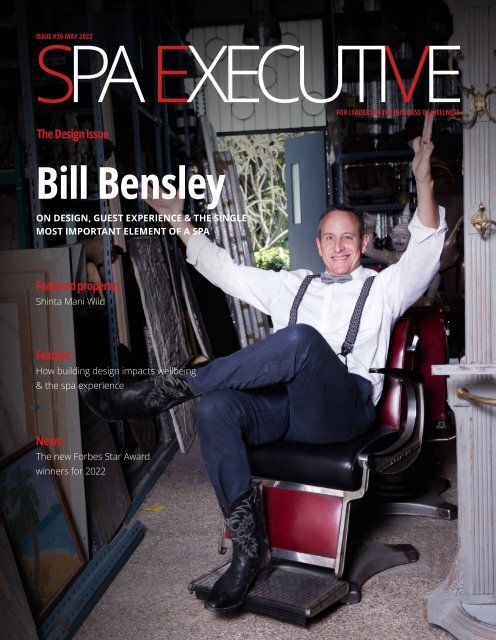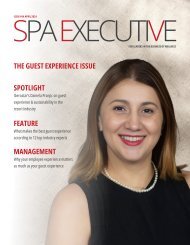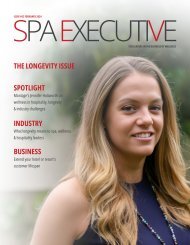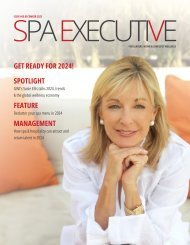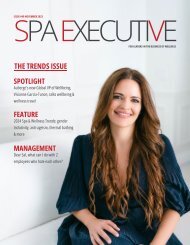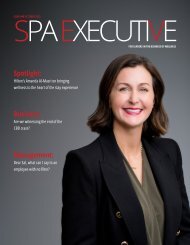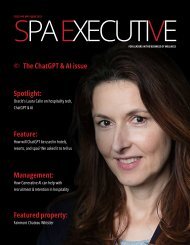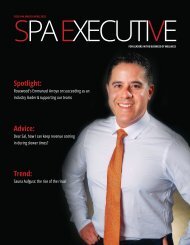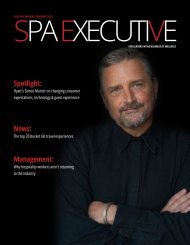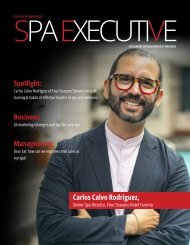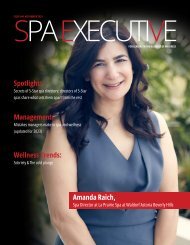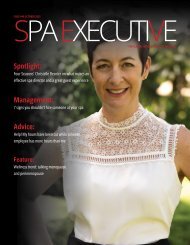SPA EXECUTIVE MAY 2022
The design issue, with Bill Bensley, Alberto Apostoli, and more.
The design issue, with Bill Bensley, Alberto Apostoli, and more.
Create successful ePaper yourself
Turn your PDF publications into a flip-book with our unique Google optimized e-Paper software.
ISSUE #36 <strong>MAY</strong> <strong>2022</strong><br />
<strong>SPA</strong> <strong>EXECUTIVE</strong><br />
FOR LEADERS IN THE BUSINESS OF WELLNESS<br />
The Design Issue<br />
Bill Bensley<br />
ON DESIGN, GUEST EXPERIENCE & THE SINGLE<br />
MOST IMPORTANT ELEMENT OF A <strong>SPA</strong><br />
Featured property:<br />
Shinta Mani Wild<br />
Feature:<br />
How building design impacts wellbeing<br />
& the spa experience<br />
News:<br />
The new Forbes Star Award<br />
winners for <strong>2022</strong>
PUBLISHER<br />
Roger Sholanki<br />
EDITOR, CREATIVE DIRECTOR<br />
Elizabeth Bromstein<br />
DESIGNER<br />
Design Pickle<br />
AD SALES, CONTRIBUTING EDITOR,<br />
PRODUCTION MANAGER<br />
Sal Capizzi<br />
Note from the Publisher<br />
Dear readers,<br />
How does design impact the guest experience? According to world-renowned architect and<br />
hospitality designer, Bill Bensley, “It’s everything!”<br />
Bensley, our Spotlight interview for this month’s design issue, is the creative mind behind some of<br />
the most breathtaking hospitality spaces around the globe. Based in Bangkok, Bensley has<br />
designed properties for Four Seasons, Rosewood, Marriott, and many more, including Bensley<br />
Collection’s own Shinta Mani Pool Villas Siem Reap and Shinta Mani Wild, in Cambodia.<br />
He told us that the single most important element of a spa is that “the relationship to mother<br />
nature is paramount,” and that “good design should be unique to where you are, an education in<br />
itself on the new culture you are immersing yourself in.” Read the entire interview here.<br />
Mother nature and a unique sense of place are themes that come up more than once. Alberto<br />
Apostoli also talked about these things in his interview about designing for wellness in <strong>2022</strong>. We’re<br />
fortunate that these two talented creatives took some time for us this month.<br />
More on nature’s impact on the spa experience can be found in articles on how design, sound,<br />
and light impact wellbeing and the spa experience. Plus, we report on a study in which scientists<br />
believe they’ve found evidence refuting the theory that smell perception – meaning the scents we<br />
like or dislike – is culturally influenced. Because how your spa smells matters too.<br />
Our featured property is Bensley Collection’s Shinta Mani Wild, a concept in Cambodia that takes<br />
glamping to a whole new level. And we’ve got a list of the new winners of the Forbes Travel Guide<br />
Five-Star Awards for <strong>2022</strong>.<br />
So much goes into creating the environments of the world’s best hotels, resorts, and spas. Let’s all<br />
take a moment to appreciate the buildings, light, nature, and sounds around us, and the people<br />
who put them together. Thank a designer today.<br />
I hope you enjoy reading this month’s articles in Spa Executive and they provide valuable information<br />
to help you achieve success.<br />
Spa Executive<br />
The online magazine for Spa<br />
Executives, featuring news<br />
and exclusive interviews.<br />
Roger Sholanki,<br />
CEO,<br />
Book4Time
Contents<br />
May <strong>2022</strong> Volume 36<br />
3<br />
15<br />
4<br />
6<br />
8<br />
11<br />
13<br />
17<br />
20<br />
FEATURE:<br />
How building design impacts<br />
wellbeing & the spa<br />
experience<br />
FEATURE:<br />
How light impacts wellbeing &<br />
the spa experience<br />
FEATURE:<br />
How sound impacts wellbeing<br />
& the spa experience<br />
FEATURED PROPERTY:<br />
Shinta Mani Wild<br />
SPOTLIGHT:<br />
Bill Bensley on design, guest<br />
experience & the single most<br />
important element of a spa<br />
RESEARCH:<br />
Is this the best smell in the<br />
world?<br />
NEWS:<br />
Forbes Travel Guide announces<br />
<strong>2022</strong> Star Awards<br />
22<br />
INSIGHT:<br />
Alberto Apostoli on finding the<br />
unique concept of wellbeing for<br />
every spa<br />
24<br />
CASE STUDY:<br />
Resorts World Las Vegas<br />
8
News<br />
How building<br />
design<br />
impacts<br />
wellbeing &<br />
the spa<br />
experience<br />
Bathhouse underground spa features original brickwork, geometric matte-black tiles, and a custom<br />
tile mural by illustrator Amit Greenberg depicting an Ancient Roman-inspired bathing scene.<br />
Design for health and wellbeing is a<br />
burgeoning field of research and study. Here’s<br />
how building design impacts wellbeing & the<br />
spa experience.<br />
The built environment of a hotel, spa, or<br />
wellness business will have a big impact on<br />
people’s experience in that building and even<br />
a direct impact on their health and wellbeing.<br />
The architects and designers creating these<br />
spaces have much to take into account, going<br />
beyond the simple safety and practicality of a<br />
structure and into its potential impact on our<br />
breath, sleep, stress levels, mood, and more.<br />
Design for health and wellbeing is, in fact, a<br />
burgeoning field of research and study,<br />
interest in which is said to be growing since<br />
the onset of the COVID-19 pandemic. We<br />
have been spending more time thinking<br />
about the design of our living<br />
environments, but also about our work,<br />
play, healthcare and vacation<br />
environments. When and why should we<br />
leave the safety of our homes for another<br />
building and what will be the impact<br />
when we do?<br />
The growing interest in<br />
wellness-focused design<br />
From office spaces and schools, to retail<br />
spaces, restaurants, hotels, resorts, and<br />
spas, how the people inside those spaces<br />
feel can have a make-or-break impact on<br />
the successful realization of their<br />
intended purpose.<br />
Research indicates that wellness-focused<br />
design may contribute to increases in<br />
employee productivity, morale, teamwork,<br />
and retention. In hospital and healthcare<br />
settings, architects and stakeholders are<br />
coming together to incorporate principles of<br />
social design into the built environment in a<br />
bid to improve patient outcomes.<br />
The design of your spa will impact the guest<br />
experience and the results of your service<br />
offerings. Air quality, noise filtering and<br />
acoustics, lighting, and the sounds and colors<br />
that you incorporate will have an impact on<br />
how people feel in that space.<br />
Design influenced by a rich history can add<br />
an experience and enhance the journey.<br />
Working with the lines and story of an<br />
existing space will inform and influence the<br />
story of how a guest feels in that space.<br />
For example, Bathhouse, in Williamsburg,<br />
Brooklyn, is located in a transformed 1930s<br />
soda factory. The space, designed by<br />
Manhattan firm Verona Carpenter Architects,<br />
houses a restaurant and subterranean spa<br />
influenced by Scandinavian saunas, Turkish<br />
hammams and Russian banyas.<br />
Bathhouse has been lauded for its unique<br />
design that stays true to the building’s<br />
04 | Spa Executive News
The Khmer Tonic Spa at Shinta Mani Wild blurs lines between indoors and out<br />
heritage. Dezeen reported that the<br />
600-square-metre underground spa features<br />
original brickwork, geometric matte-black<br />
tiles, and a custom tile mural by illustrator<br />
Amit Greenberg depicting an Ancient<br />
Roman-inspired bathing scene.<br />
And, let’s not forget how things smell. What<br />
people smell in your space is of the utmost<br />
importance. Interestingly, new research<br />
suggests that vanilla is the most loved smell in<br />
the world.<br />
Incorporating natural elements into design,<br />
including plants and water features may<br />
have a positive impact, as exposure to<br />
nature is said to enhance wellbeing and<br />
health outcomes.<br />
More aspects of wellness design include<br />
whether furniture is actually comfortable,<br />
rather than simply nice to look at, and places<br />
for social gathering, as people have always<br />
craved community.<br />
Spas should be welcoming and relaxing<br />
environments, while fitness areas must not be<br />
too sleepy, but rather, lend themselves to<br />
motivation. It’s a lot to think about.<br />
The built environment and interior design<br />
of your spa affects your team too<br />
And your guests are not the only people to<br />
consider. You want your staff to feel<br />
comfortable, at ease, motivated to provide the<br />
best service, and you want them to be happy<br />
when they come to work. The spaces where<br />
they rest, rejuvenate, and eat, should be<br />
among the top concerns. Comfortable seating<br />
and appropriate lighting matter. Your team<br />
members also need windows and plants,<br />
where possible.<br />
Blurring the lines between indoors and<br />
outdoors is among the best strategies, so<br />
people can sit in the sun and breathe fresh air<br />
whenever possible, and another increasingly<br />
popular design strategy.<br />
Bill Bensley’s designs are excellent examples<br />
of this. Among them are the Khmer Tonic Spa<br />
at the stunning Shinta Mani Wild in Cambodia,<br />
which features two treatment rooms nestled<br />
amid giant natural rocks in the forest canopy.<br />
Though most spa directors and managers are<br />
unlikely to be designing a spa themselves, an<br />
understanding of wellness design principles<br />
employed in your space will help you optimize<br />
their efficacy. Take note of the elements that<br />
create and contribute to particular<br />
experiences and positive spaces – a smell, a<br />
color, a soft fabric, and the light coming<br />
through a particular window – to enhance a<br />
tranquil or memorable moment.<br />
05 | Spa Executive News
News<br />
How light<br />
impacts<br />
wellbeing &<br />
the spa<br />
experience<br />
The best light for relaxation in your spa<br />
environment includes natural light and<br />
possibly blue light, according to research.<br />
Here’s how light impacts wellbeing and the<br />
spa experience.<br />
Light impacts human health and wellbeing in<br />
various ways. Light is critical to our daily<br />
activities and wellbeing, impacting health<br />
and human function by enabling<br />
performance of visual tasks, controlling the<br />
body’s circadian system, affecting mood and<br />
perception, and facilitating direct absorption<br />
for critical chemical reactions within the<br />
body (Source: Impact of Light on Outcomes in<br />
Healthcare Settings).<br />
The invention of the electric light bulb forever<br />
changed the way humans construct our daily<br />
lives and had many positive effects, like<br />
allowing us to extend the day and social<br />
activities after sundown and drastically<br />
reducing the risk of house fires. But there<br />
were downsides also, that include a reduced<br />
reliance on and appreciation for natural light.<br />
Natural light can have measurable<br />
health benefits<br />
Natural light is the preferred light source for<br />
most people. A study examining the impact<br />
of natural light on staff satisfaction in<br />
healthcare settings found that 43% rated<br />
increased natural light as having a very<br />
positive impact on their work life, and 27%<br />
rated it as having a positive impact. And, in<br />
another survey by Future Workplace,<br />
employees ranked “access to natural light<br />
and views of the outdoors” as their number<br />
one desire for a workplace environment.<br />
Direct exposure (not through a window) to<br />
natural light boosts absorption of vitamin D, a<br />
critical nutrient for preventing bone loss, and<br />
reduces the risk of heart disease, weight gain,<br />
and various cancers. Exposure to natural light<br />
also helps reduce the risk of seasonal<br />
depression when days get shorter in fall and<br />
winter and improves sleep quality (even<br />
through glass).<br />
A 2014 study published in the Journal of<br />
Clinical Sleep Medicine found that workers in<br />
environments with windows had significantly<br />
more light exposure during work hours and<br />
slept an average of 46 minutes more per<br />
night during the workweek than workers in<br />
environments without windows. Workers<br />
without windows reported more sleep<br />
disturbances and poorer sleep quality.<br />
More research has found that length of stay<br />
was shorter for hospital patients whose<br />
beds were near windows than for those<br />
near doors, and workers who were exposed<br />
to natural light experienced an 84% drop in<br />
06 | Spa Executive News
issues such as headaches, eyestrain, and<br />
blurred vision. Among hospital patients<br />
undergoing spinal surgeries, those on the<br />
bright side of a hospital unit were exposed<br />
to 46% higher-intensity sunlight on average<br />
than those on the dim side. The study<br />
found that patients on the bright side<br />
experienced less perceived stress and took<br />
less analgesic medication per hour than<br />
those on the dim side.<br />
The color of relaxation<br />
None of this means that artificial light does<br />
not have its place. Without it, we’d spend a lot<br />
more time in the dark and, in fact, there’s<br />
evidence to suggest forms of light therapy<br />
with artificial light can help treat depression<br />
and slow the process of dementia. But we<br />
to three times faster than conventional white<br />
lighting. Inc.com reports that separate<br />
research has found subjects report feeling<br />
relaxed more quickly in blue lighting, and that<br />
“some municipalities are even experimenting<br />
with using blue lighting on train platforms to<br />
calm the agitated and reduce the risk<br />
of suicide.”<br />
More factors to consider include the intensity<br />
and direction of the light.<br />
When planning the lighting design of your spa<br />
environment, or any other environment<br />
where the primary purpose is to create a<br />
relaxing atmosphere and promote wellbeing,<br />
one might consider incorporating blue light<br />
where appropriate. But natural light, if<br />
possible, is a must.<br />
can’t just go out and buy any old light bulb<br />
when creating an environment designed for<br />
relaxation and stress relief.<br />
If you’re looking for relaxing light color, you<br />
might consider blue. An interesting 2017 study<br />
found that blue speeds up the relaxation<br />
process after acute psychosocial stress to up<br />
07 | Spa Executive News
How sound impacts<br />
wellbeing & the spa experience<br />
The sound of your spa environment has an<br />
impact on how people feel when they’re in it.<br />
Here’s how sound affects stress levels and the<br />
guest experience in your spa.<br />
The sound of your spa environment affects<br />
how people feel when they’re in it.<br />
We know that loud noise exposure can impact<br />
the ear and cause hearing loss, and studies<br />
suggest it can have other detrimental health<br />
effects. Traffic and airport noise exposure, for<br />
example, is linked to cardiovascular events like<br />
heart attack and stroke. Noise has even been<br />
linked to increased blood glucose levels and<br />
increased risk of diabetes.<br />
Noise is a nonspecific stressor<br />
According to a paper published in<br />
Antioxidants & Redox Signaling, noise is a<br />
nonspecific stressor that activates the<br />
autonomic nervous system and endocrine<br />
signaling, and chronic low noise levels are<br />
associated with disturbances of activity, sleep,<br />
and communication, “which can trigger a<br />
number of emotional responses, including<br />
annoyance and subsequent stress.” And we<br />
know, of course, that stress is associated with<br />
negative health outcomes, including<br />
cardiovascular risk factors.<br />
Loud noise probably isn’t a major consideration<br />
in your spa (we’re assuming you’re not hiring<br />
industrial metal bands to play live shows in<br />
your pool area), but the way sound carries and<br />
the sonic environment as a whole can still have<br />
a positive or negative impact on the guest.<br />
How far a voice travels or construction or<br />
street noises from outside can interrupt an<br />
otherwise blissful experience. These are things<br />
to be mindful of.<br />
And what, at the other end, constitutes a<br />
relaxing sonic environment? Silence, they say,<br />
is golden, but not necessarily always ideal.<br />
Some sounds may be able to induce a trance<br />
or relaxation state, as evidenced in the<br />
practice of sound therapy and the use of<br />
singing bowls. And music is, of course, a<br />
familiar element often incorporated into the<br />
treatment experience.<br />
Music may increase revenue<br />
Did you know that music can have a positive<br />
impact on business?<br />
According to a study by Music Works:<br />
08 | Spa Executive News
1/3 of customers are willing to pay<br />
5%<br />
more in businesses that play music.<br />
3/4 of employees enjoy<br />
going to work more when<br />
music is played, and 1/3<br />
are less likely to take time<br />
off sick.<br />
More than<br />
50%<br />
of customers spend more time in<br />
stores that play music.<br />
81%<br />
of people prefer hair salons that<br />
play music.<br />
Music in waiting rooms<br />
makes over 3/4 of people<br />
feel more relaxed.<br />
while driving.” This may or may not<br />
be hyperbole.<br />
The song’s harmonies, rhythms, and bass lines<br />
are purportedly designed to slow the heart<br />
rate, reduce blood pressure, and lower levels of<br />
the stress hormone cortisol. Listening to<br />
“Weighless” was also said to slow breathing and<br />
reduce brain activity. Subjects reportedly<br />
experienced a 65% reduction in overall anxiety.<br />
The eight-minute-long track features guitar,<br />
piano, and electronic samples of natural<br />
soundscapes overlayed with chants. It contains<br />
a sustaining rhythm that starts at 60 beats per<br />
minute and gradually slows to around 50.<br />
Lyz Cooper, founder of the British Academy of<br />
Sound Therapy, told Spa Executive in 2019 that<br />
a person’s heart rate will gradually slow to<br />
match the pulse of the track, which leads to a<br />
fall in blood pressure.<br />
The sound of birds and water<br />
The researchers wrote: “The results affirm<br />
that natural sounds improve health, increase<br />
positive affect, and lower stress and<br />
annoyance … Raising awareness of natural<br />
soundscapes at national parks provides<br />
opportunities to enhance visitor<br />
health outcomes.”<br />
Open the window and let the sounds of birds<br />
and water into the spa – but close it when it<br />
gets too noisy out there.<br />
Don’t, however, assume everyone wants to<br />
listen to new age music or typical “spa”<br />
sounds. Offering a music menu is one good<br />
way to ensure the guest gets to hear what<br />
they want. Just make sure your walls aren’t so<br />
thin that, if the person chooses pop music or<br />
a bombastic symphony, the guest next door<br />
who opted for the New Age drone isn’t<br />
listening to Beethoven’s 9th.<br />
The most relaxing music in the world<br />
In 2011, researchers claimed to have found<br />
the world’s most relaxing music. The track<br />
most likely to chill you out, they said, is<br />
“Weightless,” by Manchester trio Marconi<br />
Union, who worked with sound therapists<br />
to create it. It was said to be so effective at<br />
inducing sleep “it should not be listened to<br />
Meanwhile, despite the caution about not<br />
everyone wanting to hear “spa music,” we do<br />
know that the sound of nature can make<br />
people feel better. A 2019 study reportedly<br />
found that gentle woodland sounds, such as<br />
birdsong and the breeze rustling leaves in the<br />
trees, are more relaxing than meditation<br />
recordings. And, research conducted in 2021<br />
found that nature sounds may positively<br />
influence health outcomes.<br />
The researchers found that people who<br />
experienced the sounds of nature felt<br />
decreased pain, lower stress, improved mood,<br />
and had enhanced cognitive performance. Bird<br />
sounds were best for combatting stress and<br />
annoyance, while the sound of water was most<br />
effective at improving positive emotions and<br />
health outcomes, a research brief stated.<br />
09 | Spa Executive News
ARE YOU PASSIONATE ABOUT THE<br />
<strong>SPA</strong> & WELLNESS INDUSTRY & DO<br />
YOU LOVE TECHNOLOGY?<br />
COME WORK FOR US.<br />
INSPIRING INNOVATION<br />
Book4Time is the global leader in spa, wellness, and leisure activity management software for the hospitality market. Our<br />
SaaS platform manages the end-to-end guest experience and back-office operations for some of the world’s top hotels,<br />
resorts, casinos, and private clubs in more than 85 countries.<br />
Book4Time is experiencing rapid growth and is hiring experienced professionals in a number of key roles including:<br />
Customer<br />
Success<br />
Software<br />
Development<br />
Marketing<br />
Product<br />
Management<br />
Sales<br />
If you thrive on innovation and are you looking for a compelling career<br />
opportunity, view our current openings<br />
@ https://book4time.com/careers/<br />
We look forward to working with you!
Featured property:<br />
Shinta Mani Wild<br />
Shinta Mani Wild guests enjoy creative luxury<br />
adventure activities, feast on delicious cuisine<br />
including local freshly foraged ingredients,<br />
relax at the Khmer Tonics Spa, and join the<br />
Wildlife Alliance anti-poaching rangers and<br />
researchers as they study the forest and<br />
its inhabitants.<br />
400-acre river valley connecting the Bokor<br />
National Park with Kirirom National Park, and<br />
set out to protect the area from poaching,<br />
mining and logging. A resort like no other<br />
grew out of the land and into 800 acres where<br />
15 tents, custom designed “to invoke the<br />
feeling of what it would have been like to be<br />
on a luxury safari in the jungles of Cambodia<br />
Shinta Mani Wild takes glamping to a whole<br />
new level in Sihanoukville, Cambodia, where<br />
the guest experience begins with a zipline<br />
with Jackie O,” now perch along 1.5 kilometers<br />
over river and waterfalls, providing exquisite<br />
views and experiences.<br />
ride over a river and waterfalls into the<br />
Landing Zone Bar where you’re handed a<br />
Gin & Tonic upon arrival.<br />
Guests are invited to enjoy creative luxury<br />
adventure activities, feast on delicious<br />
cuisine including local freshly foraged<br />
The resort, part of the Bensley Collection, was<br />
born out of an altruistic land purchase.<br />
Renowned resort designer, Bill Bensley,<br />
identified the unprotected wildlife corridor, a<br />
ingredients, relax at the Khmer Tonics Spa,<br />
and join the Wildlife Alliance anti-poaching<br />
rangers and researchers as they study the<br />
forest and its inhabitants.<br />
11 | Spa Executive Featured Property
Signature activities include:<br />
Wildlife Alliance Rangers<br />
Anti-Poaching Patrol<br />
Butterfly Walk<br />
Jungle Trekking<br />
acupuncture techniques and passive<br />
stretching. Spa offerings are included in the<br />
room rate and include natural heat healing, a<br />
full-body scrub, and a detoxifying facial, and<br />
can be enjoyed anywhere on the property, like<br />
on the deck of their tent, atop a jungle peak, or<br />
aboard a custom Bensley expedition boat.<br />
Forest Foraging<br />
Mountain Biking<br />
Kayaking<br />
Expedition Boat<br />
Bird Watching<br />
Camera Trap Walk<br />
The Headquarters Restaurant serves up a<br />
daily changing menu of dishes derived from<br />
local ingredients grown in the wild paradise<br />
garden, where guests can sample native nuts,<br />
juicy jungle fruits, and rice paddy herbs.<br />
Guests can also sign up for a private cooking<br />
class or arrange a bespoke culinary<br />
experience of their own making.<br />
Khmer Tonics Spa at Shinta Mani Wild<br />
The signature spa, Khmer Tonics, features two<br />
treatment rooms nestled amid giant natural<br />
rocks in the forest canopy. The spa’s wood<br />
and stone design is in tune with the forest,<br />
while the river takes center stage, and guests<br />
can enjoy a river-stone foot massage while<br />
soaking in a waterfall pool.<br />
The treatment menu celebrates Cambodia with<br />
chemical-free tonics made from a mix of<br />
medicinal plants, herbs, and spices, all of which<br />
are present in the surrounding rainforest.<br />
Guests can experience the traditional Khmer<br />
art of healing with a full body massage using<br />
12 | Spa Executive Featured Property
Bill Bensley on design,<br />
guest experience & the single most<br />
important element of a spa<br />
Landscape architect, architect, and designer<br />
Bill Bensley on designing for wellness,<br />
sustainability, the importance of<br />
incorporating nature, and much more.<br />
Bill Bensley is a landscape architect,<br />
architect, and designer, renowned and<br />
sought after in the hospitality world for<br />
astonishing, creative, and whimsical<br />
designs of luxury hotels, resorts, and spas.<br />
At his Ateliers in Bangkok and Bali, simply<br />
called BENSLEY, Bill employs a team of<br />
150 interior designers, architects,<br />
landscape designers, artists, and “makers<br />
of all things beautiful.” They have created<br />
spaces for more than 200 hotels, resorts,<br />
and palaces in nearly 40 countries. These<br />
include designs for Four Seasons,<br />
Rosewood, Marriott, and many more,<br />
plus Bensley Collection’s own Shinta Mani<br />
Pool Villas Siem Reap and Shinta Mani<br />
Wild, in Cambodia.<br />
Shinta Mani Wild is an all-inclusive luxury<br />
tented camp, described by Bill as “a utopia<br />
of sustainability”. It is located deep in the<br />
South Cardamom National Forest on land<br />
Bill purchased with his business partner<br />
Sokoun Chanpreda to save it from poaching<br />
and logging. Upon arrival, guests zipline<br />
400 meters over the forest canopy, a river<br />
and waterfalls into the “Landing Zone Bar”.<br />
The camp experience offers a variety of<br />
activities to push people beyond their<br />
boundaries and explore the natural<br />
environment. The design of 15 onsite tents<br />
is inspired by King Sihanouk and Jackie<br />
Kennedy’s 1967 Cambodian travels.<br />
Sustainability is one element Bill integrates<br />
into all of his designs, in his hopes of being<br />
part of a wave on which the hospitality<br />
industry bands together to help reverse<br />
climate change. His open-source white<br />
paper “Sensible Sustainable Solutions” was<br />
launched in January 2020 and is available<br />
here on his website.<br />
Another important element for Bill is<br />
having fun. In 2017, when he was inducted<br />
into the Hospitality Designs Hall of Fame,<br />
he told CNN, “If it’s no fun, don’t do it. If<br />
you’re not having fun, then you’re not<br />
13 | Spa Executive Spotlight
going to do a good job. Everybody in our<br />
studio here … we’re all about having fun.”<br />
We spoke to Bill Bensley about designing<br />
for wellness, sustainability, the importance<br />
of incorporating nature, and much more.<br />
Can you please talk a bit about your career<br />
trajectory and what drew you to<br />
architecture and design?<br />
It actually started with career day at<br />
school. We had to call people and ask them<br />
to come speak – I accidentally dialed the<br />
wrong number in the phone book (I was<br />
aiming for the fire department) and ended<br />
up speaking to a man called Rocco, who<br />
was a landscape architect. He visited my<br />
high school with a spectacular slide show<br />
of his work at Knotts Berry Farm – a nearby<br />
amusement park, like a western<br />
Disneyland, that I had been visiting for<br />
years. The idea of getting to design a place<br />
that brings so much fun and joy to<br />
thousands of people on a daily basis was<br />
the lightbulb moment. I knew I had to be a<br />
landscape architect. Rocco and I are still in<br />
touch and I often thank him, all this time<br />
later. After college at Harvard, by way of<br />
scholarships, I came to Asia and cut my<br />
teeth building many exotic gardens, mostly<br />
in Bali, but honestly, I did not like most of<br />
the hotel buildings I was asked to tart up<br />
with my tamed jungles. After some time in<br />
Singapore and Hong Kong I came to<br />
Bangkok and set up shop in 1989… and<br />
here we are! I never thought I would one<br />
day be at the top of my game in South East<br />
Asia, as a landscape architect and hotel<br />
designer by the time I was 60.<br />
Your designs are breathtaking. Can you share<br />
some of the factors you consider when designing<br />
hospitality spaces?<br />
Why thank you! Good design, at least in my<br />
playbook, rarely fails when it follows the 3<br />
Es: it should EDUCATE visitors and teach<br />
them something new, champion the<br />
ENVIRONMENT, and provide a unique<br />
EXPERIENCE… ticking those boxes, one<br />
rarely goes wrong.<br />
Take Shinta Mani Wild. The lesson there was<br />
teaching the world that conservation is a<br />
viable alternative to extraction, building a<br />
tented camp in a preserved forest – without<br />
cutting down any trees – and using it as a<br />
means to fund protection from poachers<br />
and loggers by the Wildlife Alliance NGO. It<br />
is packed with experiences, from following<br />
the rangers on patrol to arriving at the lobby<br />
by way of a leap of faith off a seven-story<br />
tower and flying along a 400 meter zipline<br />
through the forest and over a waterfall, and<br />
being handed a G&T on landing. One, I think,<br />
will have bragging rights for the rest of their<br />
life? I want guests to be able to feel the<br />
pride and joy that I feel in being involved on<br />
the real honest to God front line of<br />
protecting the Cardamom National Park,<br />
while also being comfortable enough to be<br />
able to fully enjoy the beauty of this true<br />
wilderness. I have learnt through a lifetime<br />
of exploring wilderness areas in 50+<br />
countries, that if one has to be fully<br />
occupied with survival or just making<br />
oneself comfortable, the beauty of a place<br />
becomes foggy.<br />
How does design impact the guest experience?<br />
It is everything, if you ask me! There are<br />
hotel chains which consider nondescript,<br />
soulless blank box rooms that look identical<br />
in every city, all over the world, good<br />
enough. But why do that when you can do<br />
something completely wonderful? Good<br />
design should be unique to where you are,<br />
an education in itself on the new culture<br />
you are immersing yourself in. One example<br />
is Capella Ubud. We started off as the<br />
landscapers on the project, and the plan<br />
architecturally was a huge hulk of a hotel<br />
that would have obliterated the natural<br />
beauty of the site, which is a valley sacred<br />
to the Balinese. Being a lover of nature and<br />
a landscape architect by training, I<br />
persuaded our good client, Suwito, to hire<br />
us to do the whole thing, and swap the<br />
boring 120 room hotel for a 24-tent camp.<br />
Capella Ubud tip toes ever so softly on the<br />
land, without cutting down a single tree,<br />
and working with a more luxurious hotel<br />
operator allowed us to raise the room rate,<br />
which is now the highest on the island.<br />
Capella Ubud was rated #1 in the world by<br />
Travel and Leisure. I am very proud of that!<br />
Are there factors you consider specifically when<br />
designing spas and wellness spaces? What<br />
makes a space healing and restful?<br />
The single most important element of a<br />
spa is that the relationship to mother<br />
nature is paramount. The guest should<br />
have the option of being outside while<br />
having perfect privacy. There is little more<br />
soothing than a massage to the sound of<br />
nature’s creatures at sunset – as I write this<br />
I am actually having a foot massage in my<br />
garden! Although I am a maximalist, I do<br />
think keeping it simple in the spa cannot go<br />
amiss. Also going local – forget the fancy<br />
French imported products, and learn from<br />
the locals – they know best!<br />
Can you talk about the importance of<br />
conservation and sustainability and why this<br />
matters to you? Why do hospitality companies<br />
need to understand the importance of<br />
these things?<br />
Conservation and sustainability should<br />
matter to all of us. Not putting nature on<br />
the top shelf has brought us to the brink of<br />
climate disaster. I was raised to care, being<br />
born in California to English immigrants<br />
who had a small farm. We were almost<br />
totally self-sustaining. I raised bees, quails,<br />
14 | Spa Executive Spotlight
chickens, ducks, rabbits, mushrooms, a<br />
huge variety of veggies, and, of course, a<br />
compost heap. Every weekend we’d take<br />
the trailer to a camp spot, and in the<br />
summer we would travel all over the<br />
states… never leaving behind more than a<br />
footprint. We learnt respect for nature. It<br />
makes me smile to hear the word<br />
sustainability used so frequently these<br />
days as though it is a new idea! At the point<br />
we are at, the importance of caring for our<br />
planet cannot be underestimated,<br />
especially big players like large<br />
corporations and hospitality companies<br />
who cause the most impact. As individuals<br />
we all must do what we can, but are a drop<br />
in the ocean compared to the single-use<br />
plastic and energy-use monsters big hotels<br />
can be.<br />
Are there design trends or developments you’re<br />
excited about?<br />
Recycling! Upcycling! Trashion! These are no<br />
longer dirty words people turn their noses<br />
up at. Naturally, I am overjoyed. I have<br />
always wanted to build a hotel made of<br />
100% recycled materials… How cool would<br />
that be? I think we are well on the way, as we<br />
are soon opening an InterContinental here<br />
in Thailand where the rooms are upcycled<br />
train carriages… we retrieved them from all<br />
over Thailand and have renovated them into<br />
16 stunning suites, with bespoke interiors to<br />
fit the very particular dimensions. Some will<br />
even become a bar and a spa! Upcycling on a<br />
big scale is the future, and I am so glad<br />
InterContinental joined us on this adventure.<br />
Can you talk about the death of luxury and how<br />
tourism will change going forward?<br />
Journalists often ask me about that old<br />
quote “Luxury is dead.” It really struck a<br />
chord with people. Having gone through a<br />
world with COVID, I think many of us have<br />
felt that luxury is the freedom to travel, and<br />
to do so safely. Going forward, the emphasis<br />
will be on exclusive experiences limited to<br />
small groups of friends or loved ones, like<br />
buying out a small hotel or house and taking<br />
it over for a holiday, like I did this winter in<br />
Mexico. I also think people will prioritize<br />
longer travel, and making the most of those<br />
trips, rather than short jaunts, as that<br />
makes all the paperwork worth it!<br />
What is your favorite project you have<br />
worked on?<br />
You may as well ask me to choose my<br />
favorite child, as hotels are very much that!<br />
If I HAD to pick one, it would be Shinta<br />
Mani Wild, as it has everything I would<br />
want in a hotel. Wilderness, conservation,<br />
great design, storytelling, and not to<br />
mention, the best arrival ever… I do love a<br />
zipline and a stiff drink!<br />
What are you working on now?<br />
I am working on a fascinating new idea for<br />
regenerative living in Portugal with an old<br />
friend, the InterContinental Khao Yai that is<br />
coming ever so soon, projects in Zanzibar,<br />
Tel Aviv, The Congo and Nepal, and a<br />
gorgeous Spa in Mayfair bringing ancient<br />
Thai Escapism to London! The party<br />
doesn’t stop.<br />
Getting a foot massage at Shinta Mani Wild<br />
15 | Spa Executive Spotlight
BOOK ONLINE,<br />
PAY ONLINE,<br />
SKIP THE LINE<br />
Enjoy the contact-less experience.<br />
Feb <strong>2022</strong> Issue • p.
Is this the best<br />
smell in the<br />
world?<br />
What’s the best smell in the world?<br />
Researchers set out to find out. Here’s<br />
what they learned.<br />
You’ve probably heard it said that, while<br />
there are, inarguably, pleasant and<br />
unpleasant odors, much of what people like<br />
and dislike aroma-wise is determined by<br />
culture and life experience.<br />
We were told exactly this in a 2017 interview<br />
with Dawn Goldworm, a nose and the<br />
founder of olfactive branding company,<br />
12.29, who said that, while some<br />
ingredients, like lavender and rose, can<br />
have calming effects, because they’re used<br />
in a variety of different ways around the<br />
world, they might not evoke these feelings<br />
in some populations.<br />
In Central and South America, for example,<br />
Goldworm said, “lavender is used in baby<br />
products. “So, if you have young children,<br />
and you’re looking to have a relaxing day at<br />
the spa, and everything is scented with<br />
lavender, you’re going to be thinking about<br />
your kids the whole time. Not that you<br />
would ever not think about your children,<br />
but maybe you wanted an hour or two<br />
to yourself.”<br />
Now, authors of a new collaborative study<br />
between researchers at Karolinska<br />
Institutet, Sweden, and the University of<br />
Oxford, UK, say they have found otherwise.<br />
The scientists conducted a study, the<br />
results of which, they argue, show that the<br />
smells we like or dislike are not influenced<br />
by culture but by the structure of the<br />
particular odor molecule.<br />
“We wanted to examine if people around<br />
the world have the same smell perception<br />
and like the same types of odor, or whether<br />
this is something that is culturally learned,”<br />
said Artin Arshamian, researcher at the<br />
Department of Clinical Neuroscience,<br />
Karolinska Institutet, in a research brief.<br />
“Traditionally it has been seen as cultural,<br />
but we can show that culture has very little<br />
to do with it.”<br />
The researchers found that certain smells<br />
were liked more than others regardless of<br />
the cultural affiliation of participants.<br />
“Cultures around the world rank different<br />
odors in a similar way no matter where they<br />
come from, but odor preferences have a<br />
personal – although not cultural –<br />
component,” said Dr Arshamian.<br />
“Indigenous populations in<br />
disparate environments”<br />
The study involved a total of 235 individuals<br />
from nine communities representing<br />
different lifestyles: four hunter-gatherer<br />
groups and five groups with different forms<br />
of farming and fishing. Some of these<br />
groups have very little contact with<br />
Western foodstuffs or household articles.<br />
“Since these groups live in such disparate<br />
odiferous environments, like rainforest,<br />
coast, mountain and city, we capture many<br />
different types of ‘odor experiences’,” said<br />
Dr Arshamian.<br />
Participants were asked to rank 10 smells<br />
on a scale of pleasant to unpleasant. The<br />
results show variation between individuals<br />
– which the researchers attribute to<br />
molecular structure (41%) and personal<br />
preference (54%) – but global<br />
correspondence on which odors are<br />
pleasant and unpleasant.<br />
“Personal preference can be due to<br />
learning but could also be a result of our<br />
genetic makeup,” said Dr Arshamian.<br />
The scents included:<br />
Vanillin – Vanilla, extracted from<br />
vanilla beans. Sweet, warm scent.<br />
Used as flavoring in baking and food.<br />
Popular fragrance ingredient.<br />
17 | Spa Executive News
Ethyl Butyrate – Fruity scent, like<br />
peaches or pineapple. Used in<br />
fragrance and in artificial flavoring in<br />
alcoholic beverages.<br />
Linalool – Flowery, spicy scent, similar<br />
to lavender and bergamot.<br />
Commonly used in fragrance.<br />
Eugenol – Spicy scent and the main<br />
element of clove essential oil. Used<br />
as a flavoring for foods and teas, and<br />
as a fragrance ingredient.<br />
2-Phenylethanol – Floral scent that<br />
smells like roses and also like<br />
carnation, orange blossom,<br />
and geranium. Common<br />
fragrance ingredient.<br />
1-Octen-3-ol – Also known as<br />
“mushroom alcohol,” has an earthy<br />
mushroom-like scent, also<br />
described as “raw chicken.” Used in<br />
fragrance and in pesticide to<br />
attract biting insects.<br />
Octanoic acid – Cheese-like odor<br />
also described as smelling like<br />
goat. Medium-chain fatty acid<br />
naturally found in palm oil, coconut<br />
oil, and human and animal milk.<br />
Used as a disinfectant and<br />
food additive.<br />
3-Isobutyl-2-methoxypryazine –<br />
Fresh bell pepper scent. Also<br />
present in the smell of coffee and<br />
spinach. Used in fragrance,<br />
detergents, candles, deodorants,<br />
gums, and candies.<br />
Dimethyl disulphide –<br />
Garlic-like scent. Natural<br />
compound emitted from bacteria,<br />
fungi, plants, and animals. Used as<br />
flavoring in food.<br />
Isovaleric acid – Pungent, cheesy, or<br />
“sweaty feet” scent. Found in feces<br />
and blood. Its volatile esters have<br />
pleasant odors and are widely used<br />
in perfumery.<br />
And the winner is….<br />
Vanilla was considered the most pleasant<br />
scent across cultures, followed by<br />
peachy/pineapple-y ethyl butyrate. The<br />
smell ranked the least pleasant was<br />
isovaleric acid, which is found in cheese, soy<br />
milk, apple juice, and foot sweat.<br />
Dr Arshamian, muses that a possible reason<br />
why people consider some smells more<br />
pleasant than others regardless of culture is<br />
that such odors increased the chances of<br />
survival during human evolution.<br />
“Now we know that there’s universal odor<br />
perception that is driven by molecular<br />
structure and that explains why we like or<br />
dislike a certain smell,” Dr Arshamian said.<br />
“The next step is to study why this is so by<br />
linking this knowledge to what happens in<br />
the brain when we smell a particular odor.”<br />
Wintergreen and maple in France and Canada<br />
These findings are interesting but not<br />
shocking. When one looks up the smells<br />
used in the study, the odors on the second<br />
half of the list are mostly described as<br />
“unpleasant.” It’s not a surprise that feces<br />
and sweat rank low in popularity no matter<br />
where you’re from. And, the suggested<br />
explanation seems obvious: we are put off<br />
by smells that can make us sick (feces and<br />
bacteria) and drawn towards smells that<br />
smell clean and/or good to eat because<br />
moving away from one and toward the<br />
other will help us live longer. Without the<br />
research, however, that’s just a hypothesis,<br />
so it is valuable. Still…do the findings really<br />
“show that culture has very little to do” with<br />
how we perceive scent? Different studies<br />
suggest otherwise.<br />
In a 2016 study, for instance, researchers at<br />
the Montreal Neurological Institute found<br />
that two people from different cultures<br />
smelling the same thing can have<br />
remarkably different reactions, even when<br />
those cultures share the same language<br />
and many traditions.<br />
In a partnership with researchers from the<br />
Lyon Neuroscience Research Centre in<br />
France, clinical neuropsychologist Jelena<br />
Djordjevic tested subjects in Quebec,<br />
Canada, for their subjective impressions of<br />
different scents, while their collaborators in<br />
France did the same with French subjects.<br />
This study used smells that are largely<br />
considered pleasant, or at least not overtly<br />
“unpleasant.” These were: anise, lavender,<br />
maple, wintergreen, rose, and strawberry.<br />
Participants were asked to smell each scent<br />
first without knowing what it was then<br />
again after being told its name. They were<br />
then asked to rate the scent on<br />
pleasantness, intensity, familiarity, and<br />
edibility. The scientists also measured the<br />
subjects’ non-verbal reactions to each<br />
scent, including sniffing, activity of facial<br />
muscles, respiration, and heart rate.<br />
They found significant differences between<br />
ratings of the same smells among the<br />
French and French-Canadian subjects. The<br />
French gave wintergreen much lower<br />
pleasantness ratings than<br />
18 | Spa Executive News
French-Canadians. A press release<br />
explained that, in France, wintergreen is<br />
used more in medicinal products than in<br />
Canada, where it is found more in candy.<br />
The French were more familiar with the<br />
scent of lavender while Canadians were<br />
more familiar with maple and wintergreen.<br />
Anise was rated similarly in the two cultures<br />
but was described more often as “licorice”<br />
in Quebec and as “anise” in France.<br />
Telling the subjects what they were sniffing<br />
increased their familiarity, pleasantness,<br />
and edibility ratings, and cultural<br />
differences disappeared or decreased<br />
Eventually she did find a formula that was<br />
dubbed “Stench Soup,” but not without trial<br />
and error.<br />
Do any smells evoke more healing and stress<br />
reducing effects in different areas of the world?<br />
It will be interesting for the spa and wellness<br />
world when more people take up the task of<br />
conducting further research on cultural<br />
perceptions of pleasant smells and if any<br />
evoke more healing and stress reducing<br />
effects in different areas of the world.<br />
Until then, don’t put any stinky feet<br />
aromatherapy treatments on your menus.<br />
when the names were provided, including<br />
for non-verbal reactions.<br />
The brief states “This study reinforces the<br />
idea that our brain’s processing of odor is<br />
not simply its reaction to the chemical<br />
compounds that make up the scent. It is<br />
influenced both by our previous experience<br />
with the scent and our knowledge of what<br />
the scent is.”<br />
The stink bomb experiment<br />
Another experiment that lends credence to<br />
the “scent perception is tied to culture”<br />
argument is Pamela Dalton’s quest to find<br />
the perfect stink bomb. Dalton, a cognitive<br />
psychologist at the Monell Chemical Senses<br />
Center, is known as the woman who<br />
created the world’s worst smell. In 1998,<br />
she was tasked with developing a stink<br />
bomb for the Department of Defense and<br />
her experiments found that people from<br />
different backgrounds and different parts<br />
of the world, who grew up smelling and<br />
eating different things, often completely<br />
disagreed about which smells were good<br />
or bad.<br />
19 | Spa Executive News
Forbes Travel<br />
Guide<br />
announces <strong>2022</strong><br />
Star Awards<br />
Forbes Travel Guide has released the latest<br />
list of Star Award winners. Check out the<br />
list of new Five-Star spas.<br />
Forbes Travel Guide (FTG), the rating system<br />
that sets the global standard for luxury<br />
hotels, restaurants and spas, has released its<br />
<strong>2022</strong> Star Awards.<br />
This year, FTG ventured into new<br />
destinations, including the Canary Islands,<br />
Greece, Ibiza and Malta. The 64th annual list<br />
features 323 Five-Star, 558 Four-Star and 401<br />
Recommended hotels; 74 Five-Star, 112<br />
Four-Star and 67 Recommended<br />
restaurants; and 102 Five-Star and 193<br />
Four-Star spas worldwide.<br />
Some highlights:<br />
Nine destinations now boast their first<br />
Five-Star hotels:<br />
Amman (Four Seasons<br />
Hotel Amman)<br />
Amsterdam (Waldorf<br />
Astoria Amsterdam)<br />
Berlin (Hotel de Rome, a Rocco<br />
Forte Hotel)<br />
Greece (Katikies Mykonos)<br />
Ibiza (BLESS Hotel)<br />
Madrid (Four Seasons Hotel Madrid<br />
and BLESS Hotel Madrid)<br />
Malta (Iniala Harbour House)<br />
Okinawa, Japan (Halekulani Okinawa)<br />
Zurich (The Dolder Grand)<br />
The U.S. has 10 new Five-Star hotels:<br />
The Chanler at Cliff Walk (Newport,<br />
Rhode Island)<br />
Chatham Inn (Cape Cod)<br />
Encore Boston Harbor<br />
E<strong>SPA</strong>CIO The Jewel of Waikiki<br />
Four Seasons Hotel One Dalton<br />
Street, Boston<br />
The Lodge at Blue Sky, Auberge<br />
Resorts Collection (Park City, Utah)<br />
Madeline Hotel and Residences,<br />
Auberge Resorts Collection<br />
(Telluride, Colorado)<br />
Rosewood Miramar Beach<br />
(Montecito, California)<br />
The Towers at Lotte New York<br />
Palace (NYC)<br />
White Barn Inn, Auberge Resorts<br />
Collection (Kennebunk, Maine)<br />
Boutique hotels made a strong showing.<br />
Standouts delivering one-of-a-kind<br />
experiences include new Five-Star properties:<br />
Casa Angelina (Amalfi Coast)<br />
The Chanler at Cliff Walk (Newport,<br />
Rhode Island)<br />
Chatham Inn (Cape Cod)<br />
E<strong>SPA</strong>CIO The Jewel of Waikiki<br />
The Hazelton Hotel in Toronto<br />
Hotel Esencia (Tulum)<br />
Iniala Harbour House &<br />
Residences (Malta)<br />
JOALI Maldives<br />
Katikies Mykonos<br />
Kudadoo Maldives Private Island<br />
20 | Spa Executive News
Park Hotel Vitznau (Switzerland).<br />
The properties around the world with the<br />
most Stars<br />
Macau and Hong Kong are hot. Quadruple<br />
Five-Star winners include MGM COTAI in<br />
Macau (the resort received four top awards<br />
for its two hotels, spa and one restaurant),<br />
and Morpheus and Grand Lisboa Hotel, both<br />
in Macau (they won awards for the hotel, spa<br />
and two restaurants). Quintuple Five-Star<br />
winners include Altira Macau and Mandarin<br />
Oriental, Hong Kong. Both achieved five<br />
awards for the hotel, spa and three<br />
restaurants. Four Seasons Hotel Hong Kong<br />
racked up six top awards for its hotel, spa<br />
and four restaurants.<br />
Wynn Resorts, meanwhile, “swept the<br />
septuple Five-Star category,” with two<br />
properties earning seven Five-Star awards:<br />
Wynn Resorts Las Vegas (four hotels, two<br />
spas and one restaurant earned the top<br />
rating) and Wynn Palace Macau (the hotel,<br />
spa and five restaurants did the same). The<br />
brand also has an octuple winner with<br />
Wynn Resorts Macau amassing eight top<br />
awards for its two hotels, two spas and<br />
four restaurants.<br />
Three new U.S. restaurants earned Five<br />
Stars: Carte Blanche, Dallas (becoming the<br />
state’s first ever Five-Star restaurant); Cara in<br />
Newport, Rhode Island; MUGEN, Waikiki.<br />
The Forbes Five-Star spas<br />
And what of the spas? The Middle East now<br />
has its very first Five-Star spas, Bulgari Spa<br />
Dubai and The Spa at Mandarin Oriental,<br />
Doha. The U.S. now has seven new<br />
Five-Star spas:<br />
Edge Spa, Park City, Utah<br />
Salamander Spa, Middleburg, Virginia<br />
The Spa at Encore Boston Harbor<br />
The Spa by Ivanka Trump at Trump<br />
International Hotel Washington, D.C.<br />
Spa Montage Palmetto Bluff,<br />
Bluffton, South Carolina<br />
Spa Ojai, Ojai, California<br />
The Wellness Floor at One Dalton<br />
in Boston.<br />
Mexico has two new Five-Star spas: Banyan<br />
Tree Spa Mayakoba in the Riveria Maya and<br />
SE Spa at Grand Velas Riviera Nayarit in<br />
Puerto Vallarta.<br />
In the United States, the states with the<br />
greatest numbers of Five-Star spas are:<br />
California (12), Florida (7) and Nevada (5).<br />
Globally, cities with the most Five-Star spas<br />
include: Macau (14), Hong Kong (5), Las<br />
Vegas (5), and Los Cabos (5). The<br />
longest-running Five-Star spa is Spa<br />
Montage Laguna Beach, which was FTG’s<br />
first Five-Star spa and has maintained its<br />
rating for 17 consecutive years.<br />
“Travel is back”<br />
“Travel is back, and as travelers look to<br />
make up for lost time with family and<br />
friends, they want memorable experiences,”<br />
said Hermann Elger, CEO of Forbes<br />
Travel Guide. “As the authority on luxury<br />
travel, Forbes Travel Guide can help. Our<br />
Star Awards showcase the world’s most<br />
outstanding hotels, restaurants and spas.<br />
Through our exacting and independent<br />
evaluation process, these award-winning<br />
properties all have raised the guest experience<br />
bar with an emphasis on what<br />
matters most to today’s luxury guest.”<br />
The complete list of NEW Forbes Five-Star spas<br />
is as follows:<br />
Asaya (Hong Kong, China)<br />
Banyan Tree Spa Mayakoba (Riviera<br />
Maya, Mexico)<br />
The Bulgari Spa Dubai (United<br />
Arab Emirates)<br />
Edge Spa (Park City, Utah,<br />
United States)<br />
Salamander Spa (Washington, D.C.,<br />
Virginia, United States)<br />
SE Spa at Grand Velas Riviera<br />
Nayarit (Mexico)<br />
The Spa at Encore Boston Harbor<br />
(Boston, Massachusetts,<br />
United States)<br />
The Spa at Mandarin Oriental,<br />
Doha (Qatar)<br />
The Spa by Ivanka Trump at Trump<br />
International Hotel Washington,<br />
D.C. (United States)<br />
Spa Montage Palmetto Bluff (Hilton<br />
Head, South Carolina,<br />
United States)<br />
Spa Ojai (Ojai, California,<br />
United States)<br />
The Wellness Floor at One Dalton<br />
(Boston, Massachusetts,<br />
United States)<br />
21 | Spa Executive News
Alberto Apostoli on sense of place &<br />
designing for wellness in <strong>2022</strong><br />
Architect and spa designer, Alberto Apostoli,<br />
shares the three most important elements to<br />
consider when designing a spa.<br />
Alberto Apostoli is an architect and spa<br />
designer. Born in Verona in 1968, he studied<br />
architecture at the University of Venice, then<br />
studied and worked throughout different<br />
European countries, before founding his own<br />
design firm in 1997.<br />
He has designed products and projects for<br />
various brands and his spa and hotel work<br />
includes Lefay Resort & Spa Dolomiti, Four<br />
Seasons Moscow, and Terme Preistoriche<br />
Resort & Spa.<br />
Apostoli seeks inspiration in the<br />
surroundings of whichever he happens to<br />
find himself. He says, “I am interested in the<br />
different cultures of the world; in my view,<br />
being Italian means being hungry for beauty<br />
wherever it may be found.”<br />
Wellness design, he says, “represents for me<br />
the culmination of my professional research<br />
because it is a synthesis of architecture,<br />
culture, philosophy and the ability of a project<br />
to speak to the body, mind and soul of people,<br />
… a way to speak of technology and poetry at<br />
the same time.”<br />
He explained that the projects he develops<br />
“always aim to address well-being,<br />
sometimes overtly, other times more subtly,”<br />
but it is this approach that defines the<br />
uniqueness of his work.<br />
Sustainability is also a key component of<br />
Apostoli’s work and has assumed a primary<br />
role “because it is inextricably linked to the<br />
concept of wellbeing for the planet, which is<br />
indispensable for the wellbeing of people.”<br />
Here, Alberto Apostoli talks about designing<br />
for wellness in <strong>2022</strong> and the most important<br />
elements to consider.<br />
How things have changed in spa design over the<br />
last couple of decades<br />
The entrepreneur has moved on from the<br />
perception of the spa area as mere facility or<br />
amenity and today understands the strategic<br />
value in wellness on the market and as an<br />
element on which an entire idea can be built.<br />
Spas can have a life of their own and<br />
constitute important businesses in their own<br />
right, whereas before they were more of an<br />
afterthought or add on.<br />
The customer of today is also more mature<br />
than the customer 15 or 20 years ago. A<br />
savvy consumer can recognize different<br />
22 | Spa Executive News
types of spas and wellness options and<br />
recognize quality.<br />
Design should evolve to keep pace with the<br />
business expectations of both consumers<br />
and stakeholders. A spa is an all-important<br />
space, the design of which deserves as<br />
much consideration as the hotel or resort<br />
where it is housed. And, in fact, may even<br />
be the seed out of which the rest of a<br />
property concept grows.<br />
Each spa is a unique concept of wellbeing<br />
There are three main elements I consider. The<br />
first is place. When designing a spa space, one<br />
must do a determined, precise and accurate<br />
analysis of the location. Wellbeing is<br />
subjective, not objective, and therefore the<br />
environment must be understood from a<br />
territorial and climatic point of view (as well as<br />
the cultural, social, religious and historical<br />
resources it possesses). Each spa becomes a<br />
search for the unique concept of wellbeing<br />
that an area can provide.<br />
The second element is sustainability: the<br />
strategies, methodologies and elements that<br />
can create a sustainable spa. The third<br />
element is the management aspect: how the<br />
spa will be managed, how customers will<br />
move, how the staff will move, maintenance,<br />
cleaning, and so forth. Creating a spa is like<br />
painting a work of art; you need to<br />
understand where the artwork will be placed,<br />
where it will be exhibited, the subject, the way<br />
in which the customer will observe the<br />
picture, and so on.<br />
Technology as the beating heart<br />
The technology within the spa is the<br />
equivalent of the engine in the automotive<br />
sector. It is the beating heart. It’s<br />
mandatory for a spa designer to know the<br />
techniques, results and expectations in<br />
terms of systems (from a thermal,<br />
thermo-fluidic, and hydro-thermal point of<br />
view, the control of lights, the sensory part,<br />
music, sounds, etc). The technology is used<br />
to power the engine but also to create a<br />
mood and a multi-sensory experience that<br />
today is the basis of every spa project.<br />
How design impact the staff as well as the guests<br />
Unfortunately, the standard approach of a<br />
designer is to design something only for the<br />
customer. The guest must be able to move<br />
with a fluidity and comfort inside the spa.<br />
There are many factors to take into account<br />
regarding the guest: they walk barefoot or in<br />
slippers, they are often in a darker<br />
environment than normal, often without<br />
glasses, are not wearing clothes, and so forth.<br />
So, the design has a substantial impact.<br />
Creating wellness is not only about aesthetics<br />
but also the use of design elements that help<br />
and make the guest feel at ease.<br />
The staff must be able to move just as well in<br />
the structure, without hindering the guest’s<br />
paths and must be able to experience the<br />
wellbeing even if in a different form. It’s<br />
important that all of these considerations are<br />
taken together to create whole experiences for<br />
both guests and staff.<br />
The importance of nature and water elements<br />
Nature is the mother of wellbeing. Man is an<br />
animal, a living being and a social animal.<br />
Nature cannot and must not be relegated to a<br />
marketing value, but must be used for its<br />
logical function. Within the natural world, water<br />
is obviously essential. As Thales, one of the<br />
most important pre-Socratic philosophers, said<br />
“water is the origin of all things.” Water can be<br />
perceived in the air content, becoming<br />
humidity; and it’s also fundamental to our<br />
perception of temperature. Water is therefore<br />
essential in spas even when it seems not to<br />
be, and since humans are made of 70% water,<br />
they absolutely cannot help but consider it.<br />
Water in all its three states – liquid, solid, and<br />
gas – is important in the spa. The perception<br />
that people have of water inside the spa is<br />
very complex. Not all of us react well to the<br />
humidity of a Hammam, a Turkish Bath or a<br />
Sauna; but it is understood that water in all its<br />
three states – liquid, solid, and gas – is<br />
important in the spa.<br />
During the design phase it should be<br />
understood how the water moves and will be<br />
used. I try to understand the repercussions<br />
that water has on individual spaces. Water in<br />
all its forms is important, but a specific<br />
analysis must be made.<br />
23 | Spa Executive News
CAS E S T U D Y<br />
RESORTS WORLD LAS VEGAS<br />
The Challenge<br />
Sprawling, state-of-the art, next-gen gaming property with<br />
complex integration requirements for spa & wellness.<br />
The Solution<br />
Book4Time, the easy-to-use spa software solution with the<br />
most integrations in the industry!<br />
The Results<br />
Happy team, smooth operations, easy booking, and more.<br />
Jennifer Lynn<br />
Spa Director at Resorts World Las Vegas<br />
Credit: Resorts World Las Vegas<br />
I find the product to be far superior to the other systems I have used over the years. The online booking<br />
platform alone is easy to use for guests and integrates well into our spa operation”.<br />
In June 2021, Resorts World Las Vegas made its debut as the first resort<br />
built on the Las Vegas Strip in more than a decade. The integrated luxury<br />
resort boasts an array of unique and extraordinary features and amenities.<br />
The sleek yet simple elegance of Resorts World Las Vegas was developed<br />
with the intention of bringing the elevated experience for which the<br />
Resorts World brand is known. Resorts World Las Vegas features 3,506<br />
guest rooms and suites across three of Hilton’s premium brands,<br />
Crockfords Las Vegas, one of the first LXR Hotels & Resorts in the U.S.<br />
Each brand features its own entrance, lobby, and distinct selection of<br />
guest accommodations. More features include an innovative,<br />
next-generation gaming floor, more than 40 world-class food and<br />
beverage options, a 5,000-capacity theater, distinct nightlife venues, an<br />
extensive retail collection boasting a wide spectrum of internationally<br />
known brands, and more.<br />
including the Las Vegas Hilton, Conrad Las Vegas, and<br />
24 | Spa Executive<br />
Case Study
At the cutting edge<br />
of technology<br />
Resorts World Las Vegas is also offering various new-age tech<br />
advancements across the property, including mobile check-in and digital<br />
key via the Hilton Honors app, allowing for a contactless arrival experience,<br />
and an AI-powered digital concierge named Red<br />
Credit: Resorts World Las Vegas<br />
AWANA Spa & Wellness at<br />
Resorts World Las Vegas<br />
AWANA Spa & Wellness at Resorts World Las Vegas is the first spa of its<br />
kind. Complete with personalized treatments, immersive facilities, and<br />
approachable wellness offerings. The modern, yet warm space draws on<br />
the principles of the golden ratio with rounded rooms, curved walls, and<br />
well-thought-out designs to promote a transformative and holistic<br />
experience. Spa goers can choose from a variety of treatments inspired<br />
by European and Eastern rituals with a unique social approach, including<br />
treatments offered for the first time in the United States, like the theatrical<br />
Art of Aufguss, showcasing a theater-inspired heated room with<br />
aromatherapy, choreographed music, lighting, and dancing towels.<br />
Jennifer Lynn is the Spa director at Resorts World Las Vegas. An<br />
inspiring spa and wellness leader with 25 years of experience in luxury<br />
brand development and a passion for hospitality, luxury service, and<br />
sustainability, Lynn oversees operations at AWANA Spa & Wellness.<br />
As the pre-opening Director of Spa and Fitness, Lynn worked diligently on<br />
the critical path to opening the spa in the fall of 2021. Her responsibilities<br />
included brand development for the spa, design and construction project<br />
management for the space, system implementation -- including software<br />
-- building a zero-based budget, and recruiting, hiring, and onboarding a<br />
champion team of 70 passionate spa professionals. Book4Time was the<br />
software of choice.<br />
“Spa software<br />
decisions should<br />
be explored fully”<br />
Credit: Resorts World Las Vegas<br />
25 | Spa Executive Case Study
“Spa software decisions<br />
should be explored fully”<br />
As industry leaders know, there’s a lot to consider when it comes to<br />
choosing a spa software, including functionality, ease of use, interface,<br />
and more. When asked what she was looking for in a software solution at<br />
the time, Lynn listed integrations as one of her top priorities. She said,<br />
“Spa software decisions should be explored fully to ensure that they meet<br />
all the right criteria for operations and property integration, perhaps even<br />
taking into consideration a need for enterprise solutions for multiple<br />
properties. At Resorts World Las Vegas, we needed to find a software<br />
that had great integration for our PMS system, OPERA.” Specifically, for<br />
AWANA Spa & Wellness, Resorts World Las Vegas’ operational needs for<br />
software include:<br />
eliminating the need to have multiple computers throughout the Heart<br />
of House areas. This allows treatment providers to review their<br />
schedules, eliminates the need for paper itineraries or agendas, and<br />
creates easy access for upgrades and enhancements.”<br />
Credit: Resorts World Las Vegas<br />
Easy to use for guest facing online booking<br />
User friendly for spa operators/end users<br />
Retail management integration (sales, inventory, and purchasing<br />
management)<br />
Payroll configuration flexibility and having a software system that is<br />
flexible<br />
Operational configuration – spa services, retail store transactions,<br />
wellness activities<br />
“We chose Book4Time,” said Lynn, “because it met all of our criteria and<br />
testing in a pre-opening setting for Resorts World Las Vegas IT<br />
standards. We also verified references from other spa operators with<br />
similar business models that were experiencing success with<br />
Book4Time. “<br />
“Treatment providers are able to use their mobile devices to check their<br />
schedules throughout the day at their fingertips, eliminating the need to<br />
have multiple computers throughout the Heart of House areas.”<br />
The fact that the software is cloud based is one of the things that stood<br />
out for Lynn. “Being a web-based program made it affordable to<br />
implement and we love to have access to our spa reservations from our<br />
mobile devices. Treatment providers are able to use their mobile<br />
devices to check their schedules throughout the day at their fingertips,<br />
26 | Spa Executive Case Study
“One of the smoothest<br />
launches I have had”<br />
The launch and implementation of Book4Time<br />
went smoothly.<br />
“With over 25 years in hospitality and spa operations management, this<br />
was one of the smoothest launches I have had. At the baseline, the<br />
software functionality and integration are key,” Lynn said. “The<br />
Book4Time team was well prepared to support a launch of a new spa<br />
within the launch of a new property. The team was well versed at<br />
managing the critical path for configuration, implementation, training,<br />
and go-live.”<br />
“Customer support has been the most impressive. As we have worked<br />
to create a system that represents the unique complexity of our<br />
operation, the support team has been very responsive to inquiries<br />
regarding configuration.”<br />
Lynn also said the payroll functionality has been a time saver. “The<br />
complexity of spa payroll could leave a scholarly mathematician<br />
confused. Book4Time has a software program that can adapt to the<br />
diversity and complexity of compensation when configured properly and<br />
makes it simpler to understand.”<br />
She adds that “Customer support has been the most impressive. As we<br />
have worked to create a system that represents the unique complexity of<br />
our operation, the support team has been very responsive to inquiries<br />
regarding configuration.”<br />
“Far superior to the<br />
other systems”<br />
How does Book4Time compare with other software systems Lynn has<br />
used in the past? Simply put: it’s better, which was exciting and gratifying<br />
for us to know!<br />
Lynn said, “The online booking platform alone is easy to use for guests<br />
and integrates well into our spa operation. I find the product to be far<br />
superior to the other systems I have used over the years.”<br />
Thanks to Jennifer Lynn and Resorts World Las Vegas for trusting<br />
Book4Time with your software needs and for your kind words. We<br />
appreciate you!<br />
Credit: Resorts World Las Vegas<br />
To learn more about how Book4Time can help<br />
your spa & hospitality business thrive visit<br />
www.book4time.com and book a demo today!<br />
27 | Spa Executive Case Study
Spa Executive<br />
FOR LEADERS IN THE BUSINESS OF WELLNESS<br />
ADVERTISE WITH US<br />
CONTACT SAL CAPIZZI FOR MORE INFORMATION<br />
SCAPIZZI@<strong>SPA</strong><strong>EXECUTIVE</strong>.COM<br />
scapizzi@book4time.com | www.spaexecutive.com


